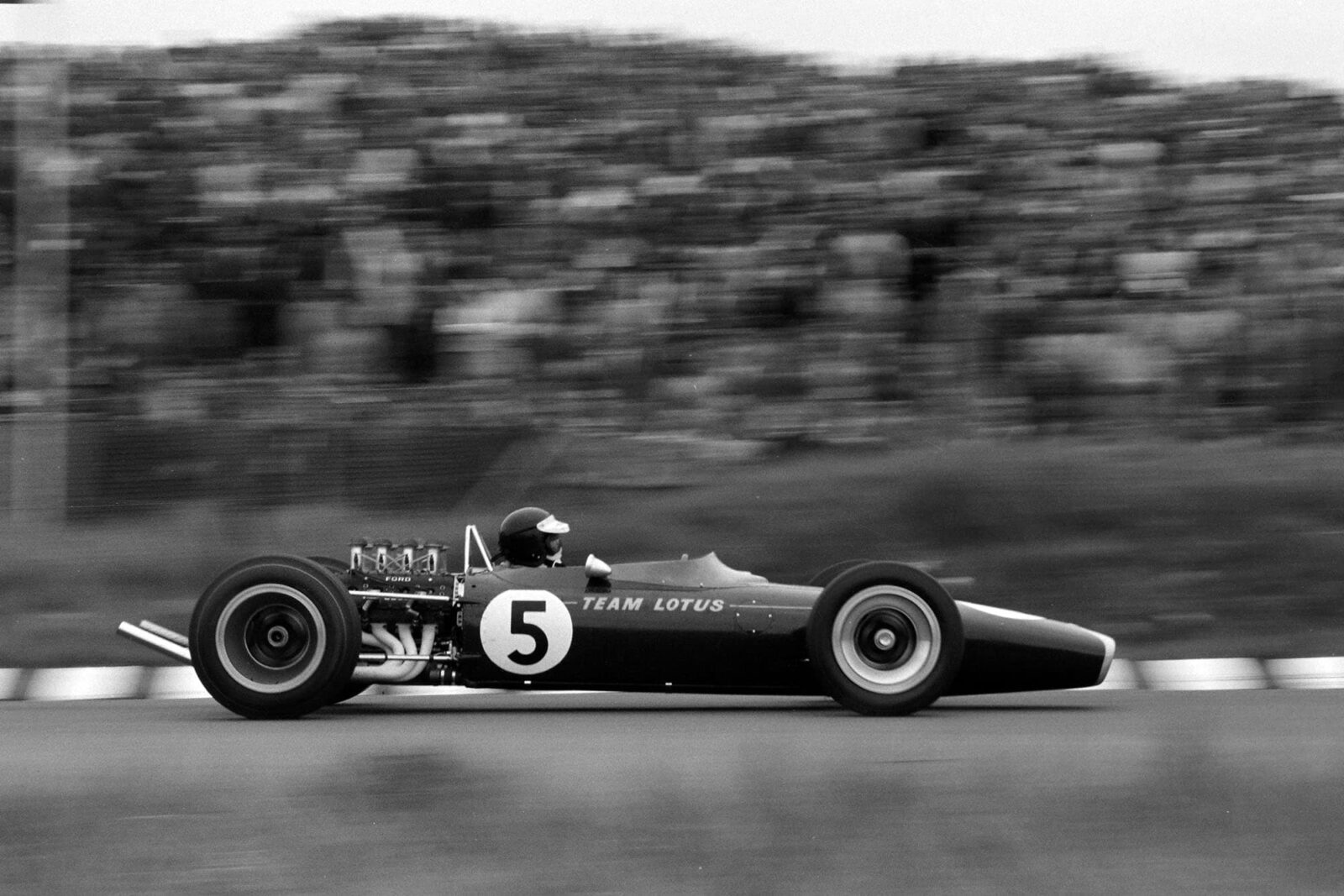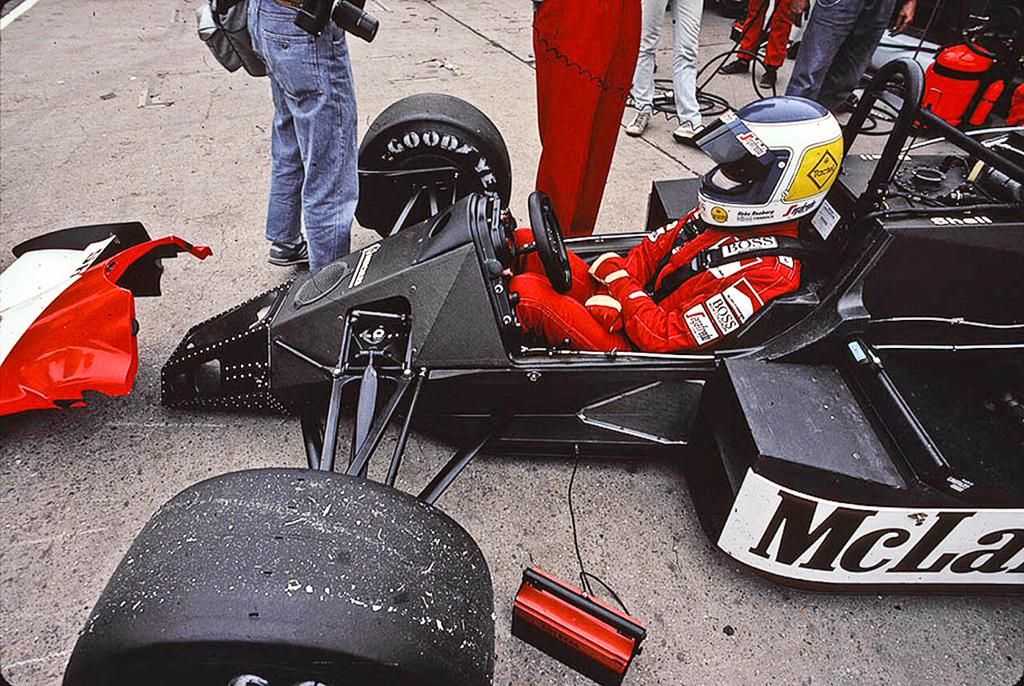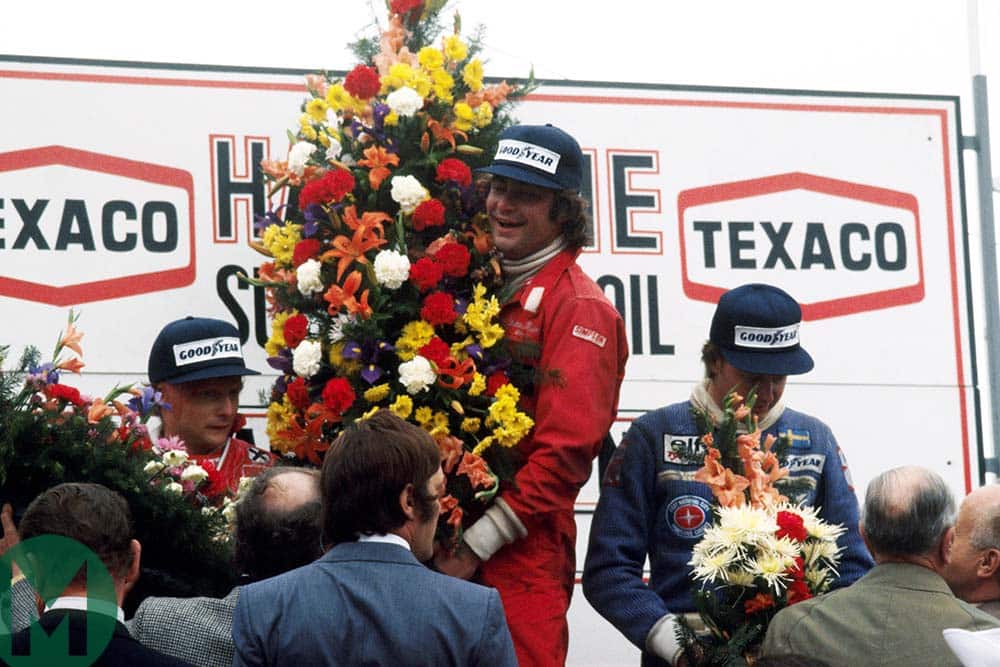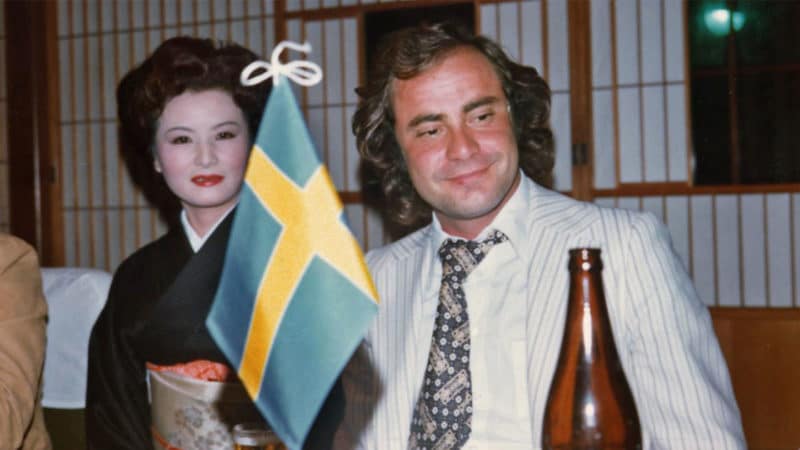Post by mikael on Jul 3, 2024 19:25:37 GMT
Ref. the 1975 Austrian Grand Prix - Vittorio Brambilla in his March at the 1975 Austrian Grand Prix, Osterreichring
1975 Austrian Grand Prix race report
Denis Jenkinson
A washout
Osterreichring, Knittelfeld, August 17thThe entry list for the Austrian Grand Prix was very full, almost to the point of overflowing as regards drivers, but after the debacles of the British Grand Prix and the German Grand Prix there was a distinct shortage of racing cars. The McLaren team were reduced to M23/9 for Fittipaldi and M23/6 for Mass, with no spare car, and Lotus had 72/R9 for Peterson and 72/R8 for Henton, also with no spare car. In the Tyrrell team Scheckter’s wreckage from the Nurburgring has been rebuilt around a new monocoque tub, making it 007/6-3, while Depailler was still happily in 007/4 in its original and virgin state. Unlike McLaren and Lotus, the Tyrrell twins did have a spare car, number 007/5. Also still enjoying a spare car luxury, and needing it, was the Brabham team. Reutemann had BT44B/1 as usual, and Pace had B4, but they both had recourse to using the spare car, B3, during the meeting. The four March cars at this race were as used in Germany, with the same driver/car combination; Brambilla 751/3, Stuck 751/2. Lombardi 751/1 and Donohue 751/5. The Scuderia Ferrari did another shuffle on their set of cars, with Lauda in 022, Regazzoni in 024 and the reserve car was 023, The BRM team were back with their usual pair of cars and it was hoped more power and more reliability, with Evans aiming to use P201/05 as the race-car. The Shadow team had more cars than they knew what to do with, Pryce as usual being in DN5/2A with 3A as the spare car, while Jarier had the brand new Matra-powered car DN7/1A. His usual car, DN5/4A was standing by ready for use but the Frenchman was not interested in it, putting all his efforts into the new car.
After his brief flirtation with Team Lotus, John Watson was back with the Surtees team, in TS16/05-4, and Frank Williams had hired out a car to the Swiss amateur driver Joseph Vonlanthen, this car being a rebuilt version of FW/03, which Ashley crashed at the Nurburgring. The Williams team had “found’ another monocoque tub in the stores and used it as the basis of the rebuild. creating FW/03-2. Laffite as usual had FW/04. In the Hill team there was a shortage of cars as GH1/1 was a write-off after Brise had crashed at the Nurburgring, so he took over the latest car GH1/4. Rolf Stommelen was making his return to the team and took over GH1/3, so that Alan Jones’ temporary contract terminated as was agreed from the start. The Hesketh team hired out their spare car 308/3 to the American driver Brett Lunger and Hunt retained 308/2, while there was no sign of the new C-type Hesketh. The Parnelli team had their usual pair of cars for Andretti and Wilson Fittipaldi had his latest Copersucar sponsored car. Morris Nunn had two entries, with Chris Amon returning to Formula One in MN/04 and Wunderink having another try in MN/02. To complete the list there was Harald Ertl, the Austrian journalist living in Germany, with the gold coloured Hesketh 308/1 and Tony Trimmer having another go with the rather sad Japanese Maki.
For some people practice never did go right, in particular the Brabham and Parnelli teams seemed to be in continual trouble with one thing or another, while Team Lotus had their troubles in large doses. Before the end of the first practice session Reutemann had come walking back to the pits, abandoning BT44B/1 with a broken Hewland transmission and Andretti abandoned Parnelli VPJ4/003 with a blown-up Cosworth engine. Reutemann set off in the spare Brabham but only went half a lap before the oil filter centre sheered off and the Cosworth engine lost all its oil, and Brambilla’s practice was cut short when his Cosworth V8 engine lost all its oil pressure, the March mechanics getting stuck in immediately to install a new engine ready for the afternoon practice. Lotus trouble arrived violently when Peterson was about to drive through on the inside of a slower car on a right-hand bend when the “rabbit” moved across in front of the Lotus. Locking up everything Peterson avoided a collision but smashed the Lotus along the barriers and at first sight 72/R9 looked to be a write-off. However, the Lotus mechanics set to work and by next morning the car was running again, Peterson in the meantime taking 72/R8 from Henton for the afternoon practice.
Lauda, as usual, was getting on with the job, out to win his home Grand Prix, and set fastest practice lap in the morning session and went even faster in the afternoon session as the temperature dropped after a very hot mid-day. Fittipaldi, Regazzoni, Pace and Depailler were not far behind the flying Austrian, but no-one else was really in the running. Unfortunately the Austrian timekeepers seemed to lose interest and they only issued afternoon times for those drivers who improved on their morning times, or at least that was all the information that came from the fancy computer that published results. In the afternoon session there still seemed to be more trouble than success with some people and after keeping up with the Matra V12-powered Shadow the BRM broke its engine and put out an enormous smoke screen. The spare BRM was brought out of the paddock but Bob Evans never came back, being stuck on the far side of the circuit with the blown-up BRM. Andretti in the spare Parnelli car, still with inboard front brakes, had his second Cosworth V8 engine blow up and Regazzoni’s Ferrari broke its engine so the Swiss had a go in the spare car. The heat and high-speed of the Osterreichring were playing havoc. Pryce had to use the spare Shadow as his own car had a fuel leak, but Jarier was still happy with the Shadow-Matra V12. Near the end of practice the front suspension broke on Wilson Fittipaldi’s car and he crashed heavily into the catch fencing, injuring a hand rather badly. Peterson found the long-wheelbase, coil-sprung Lotus 72/R8 somewhat different from his own car but did not show any improvement in lap times. Hunt joined the fancied runners with a very good afternoon time that put him second overall, and the general pace was really hotting up. Scheckter seemed to be left behind, as did a number of other fancied runners.
On Saturday morning the weather had changed completely and it was cool and damp and not conducive to high-speed laps. The mechanics had done an enormous amount of work in the paddock and most teams were back to square one. Henton was back in the long-wheelbase Lotus R8, while Peterson was back in the rebuilt R9. Andretti was back in 003 with the outboard front brakes and a new engine, while another engine was put in the BRM, and Ferrari had replaced the engine in Regazzoni’s car, and Reutemann was back in his own car while Pace had a go in the spare Brabham. The dampness on the track added more than two seconds to the lap times, so only those with specific things to try bothered to go out until conditions improved, though they never got as good as Friday and it was Stuck who made fastest lap on Saturday morning.
Towards the end of the session things began to speed up a bit but then all manner of troubles occurred. Andretti blew up his third engine of the meeting, the team now down to one remaining engine in the spare car, and Pace reverted to his own Brabham BT44B/4 only to complain of a “funny feeling”. This manifested itself a few laps later in the left-rear stub axle breaking and sending the car spinning into the barriers on the flat-out right-hand bend at the top of the hill after the pits. Not long after that had been cleared up the Maki came to rest with no drive to the rear wheels and then Henton crashed his Lotus which ended all his hopes of a race, for the team had run out of spare suspension parts, having used them all up on Peterson’s car.
The change in the weather had come to stay and before the last practice session began the rain had come. There was a complete reluctance for anyone to venture out for quite a time but then someone mentioned that it might rain on the following day, which was race day, so most of the drivers had wet weather tyres fitted to their cars and set about finding out what the Osterreichring was like in the rain, and of the times given Regazzoni was fastest. What had started off as a cracking good two days of practice degenerated into a rather miserable and damp affair, but the crowds were happy as Lauda was on pole position for the start and the British were happy for Hunt alongside him. The whole atmosphere of the Osterreichring has grown rapidly into an enormous camping, beer and sausage festival and the crowds were enormous in spite of the damp conditions.
Sunday morning was bright and sunny and the campers were busy drying out while the bright light was not helping the headaches of the beer-drinkers. The regulation early morning untimed testing session soon got underway and all seemed set for a really good Austrian Grand Prix. A crowd of up to 140,000 was estimated and they all seemed to be in place by 9 a.m. While the test session was in full swing Mark Donohue had a front tyre go flat on the Penske March 751 as he was taking the flat-out right-hand bend at the top of the hill after the pits. The March veered off the track into the catch nets, mowing them down as it went. They snowballed under the car and launched it over the Armco barrier, striking two Marshals as it went. Donohue seemed unhurt, apart from a blow on the head and was returned to the paddock hospital quite coherent. The Marshals were taken to hospital with bad injuries and one of them subsequently died. Donohue was flown by helicopter to Graz hospital for a check-up, but on the way internal head complications set in and he had to be operated on immediately. It was with deep shock that we learned later he had died on the following Tuesday.
This accident not only stopped the test session but delayed the programme of supporting races and threw the organisation into mild chaos so that nobody seemed to know what was going to happen. The supporting races were reduced in length, but the remainder of the test session for the Formula One cars were allowed. All the while the lovely sunny day was fast disappearing and an ominous bank of rain clouds was building up behind the mountains overlooking the circuit. While the organisation was having trouble so were some of the teams, Brabham and Parnelli in particular. After his practice crash Pace had elected to race the spare car, but during testing an oil seal failed in the engine, so he had to revert back to his regular car. Reutemann was also in trouble as a fuel bag was leaking and had to be changed in a panic, and the Shadow team had had to change a fuel bag on the Matra-engined car. The Parnelli was overheating its oil so the larger radiators off the spare car were fitted to 003 and just before it looked as though the race might start the BRM had engine trouble and Evans switched to the spare car. There had been a lot of changing of front tyres after Donohue’s crash and with the approaching rain the pits were knee-deep in tyres, so it was not surprising that the Brabham team got in a muddle and sent their cars to the start on unmatched pairs of rear tyres, as regards overall diameter, but this was not discovered until the race was over!
With Donohue out of action and Henson without a car the grid was reshuffled to let in Vonlanthen and Wunderink, and finally, after so much hanging about that the crowd began to get belligerent, 26 cars faced the starter. In appalling conditions the race started with Lauda taking the lead followed by Hunt, while Depailler shot through from the fourth row into third place before they had passed the end of the pits. The spare BRM went out almost immediately with engine trouble and Andretti went off the track, so lap 3 saw only 24 cars go by in great spumes of spray. Pace’s engine sounded awful, as did Vonlanthen’s, but it was remarkable that the rest ran so well in view of the amount of water about. At 5 laps Depailler was suffering from front wheels that appeared to be out of balance and Brambilla passed him into third place, but Lauda and Hunt were quite a long way out in front of him. Behind Depailler came Stuck, Peterson, Fittipaldi, Mass, Pryce and Brise, the last three really getting to grips with the conditions once they had got through the incredible spray of the opening laps.
By 10 laps the heavy rain had stopped and it almost looked as though it might dry up, which would have meant a mad rush into the pits for dry-weather “slick” tyres. Lauda looked to be firmly in the lead and it just seemed a formality for him to reel off the 54 laps and win yet another Grand Prix for Ferrari. Hunt was holding a good second place, but Brambilla was getting closer; Peterson was showing some of his old fire and was up to fourth place, followed by Depailler, Fittipaldi, Pryce, Brise and Regazzoni, the rest being too far behind to be of much consequence. Scheckter had dropped from seventh place on lap 4 when he got a puncture and had to drive slowly to the pits for a new tyre. but was now going strongly and gaining ground on the slower runners. Stuck spun off the circuit on lap 12 and on lap 14 Brise had a balance weight come off a wheel and had to make a hurried stop to change the out-of-balance wheel.
Now the rain returned with a vengeance and Lauda was not at all happy with the handling of his Ferrari on the streaming track and at the end of lap 14 he had Hunt and Brambilla tight up behind him. As he relaxed his effort on lap 15 they both shot by him in a pretty unruly and forceful manoeuvre and in torrential rain Hunt led the Austrian Prix for the Hesketh team, but Brambilla was pressing him hard, the swarthy Italian feeling really confident with the handling of the works March on the streaming track. He pressed hard for three laps and look the lead on lap 19, pulling away so fast that seemed the Hesketh must be in trouble; but it wasn’t and Hunt held on to second place ahead of a very dejected Lauda. In the pits Pace retired with all sorts of things not to his liking and DepaiIler stopped for a new pair of front wheels and then Peterson stopped to change his yellow visor for a clear one, losing a good fourth place in the process. As the rain continued Lauda was passed by Mass and then by Pryce and looked in danger of being passed by his team-mate Regazzoni, who had Peterson charging after him in a most spirited fashion. At 26 laps the rain was heavier than ever, with thunder and lightning all around and a deputation from the team managers was lobbying the organisers to stop the race.
While Brambilla was away on his 29th lap the chequered flag was waved as Stommelen passed and the race was over. When Brambilla finished lap 29 he saw the chequered flag, waved to his pit crew and promptly went sideways up the streaming track and thumped the barriers, bouncing back into the middle of the road. and carrying on with the front of the March all smashed up. Everyone skated over the finishing line, somewhat relieved, and on that last lap Mass had spun off the circuit but got back on again, losing third place to Pryce, and Peterson passed Lauda to take fifth place. Eighteen cars finished this very unsatisfactory race and as the shouting and yelling went on in the pits between those who wanted to restart the race and those who had had enough, the rain eased right off and it began to dry up; it was too late, the race had been stopped with the chequered flag, it had gone more than half-distance and was over.
It was another unsatisfactory Grand Prix in this troubled year of 1975 and one wonders if it is not all due to too many people and too many unions trying to run Grand Prix racing. Nobody denied Brambilla his victory for he had out-driven everyone on the streaming wet circuit, the March 751 being admirably set up for the conditions, unlike a lot of the opposition. It was not only Brambilla’s first Grand Prix victory but also the first for March Engineering, previous March victories being scored by the Tyrrell team. It is over five years since March Engineering burst upon the racing scene and a lot of people predicted they would sweep the board. Five years to the first Grand Prix win, and only half a Grand Prix at that, is a long time, but the road is a hard one.
— D.S.J.
Source:











 but I have a slot car of Lella in the March!
but I have a slot car of Lella in the March!














